“JUNO PROBE MAKES HISTORY BY ENTERING JUPITER’S ORBIT AFTER FIVE-YEAR JOURNEY”



“JUNO PROBE MAKES HISTORY BY ENTERING JUPITER’S ORBIT AFTER FIVE-YEAR JOURNEY”
Last night, NASA and its Juno probe made history by entering a new probe in orbit around Jupiter. The Juno spacecraft, which had left Earth five years ago, finally entered Jovian orbit after a 35 minute rocket engine manoeuvre to slow down its approach to the planet and get caught by its gravity. Unlike other engine firings in the past, Juno’s manoeuvre was especially dangerous since no previous spacecraft had ever dared to pass so close to Jupiter; its intense radiation belts can destroy unprotected electronics. Luckily, since the probe was built like a tank with titanium shielding, a few minutes later, a sequence of tones transmitted from the spacecraft confirmed the braking manoeuvre had been a smashing success prompting wild cheering at NASA’s mission control in Pasadena, California. “All stations on Juno co-ord, we have the tone for burn cut-off on Delta B,” Juno Mission Control had announced. “Roger Juno, welcome to Jupiter.” Juno’s main objective is to sense Jupiter’s structure and chemistry to gather clues on how the gas giant formed some four-and-a-half-billion years ago. However, much of this observation will not take place until mid-October when Juno performs a second rocket engine burn to tighten its orbit to just 14 days. By then, Juno will be able to answer some interesting questions about the planet including where it formed in the early Solar System and whether Jupiter has a solid core or a core made of compressed gas. After the mission ends, Juno is scheduled to dive into Jupiter’s atmosphere in February 2018 to ensure that there is no possibility of it crashing into and contaminating any of Jupiter’s large moons.
Read more about this fascinating story on: http://www.bbc.com/news/science-environment-36710768
More Posts from Astrotidbits-blog and Others
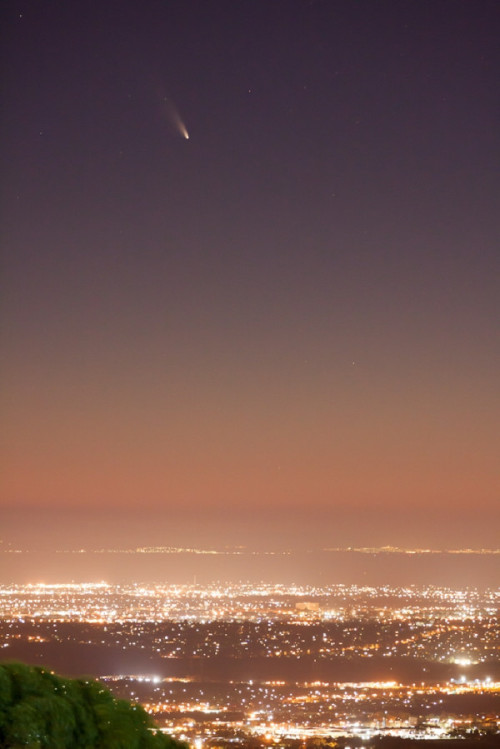
Comet PanSTARRS
Gorgeous picture of Comet PanSTARRS taken by Carl Gruber on March 2, 2013 at a mountain lookout in Melbourne.
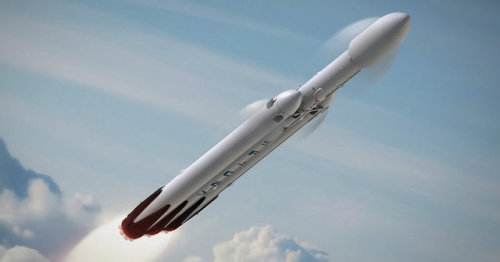
SpaceX Plans to Send 2 Tourists Around Moon in 2018
“While the trip appears to be within the technical capabilities of SpaceX, industry observers wondered whether the company could pull it off as quickly as Mr. Musk indicated. “Dates are not SpaceX’s strong suit,” said Mary Lynne Dittmar, executive director of the Coalition for Deep Space Exploration. The Dragon 2 and Falcon Heavy are years behind schedule and have yet to fly.“It strikes me as risky,” Dr. Dittmar said, adding that autonomous systems are not infallible. “I find it extraordinary that these sorts of announcements are being made when SpaceX has yet to get crew from the ground to low-Earth orbit.””
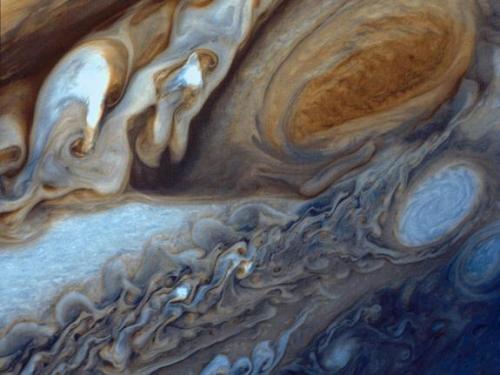
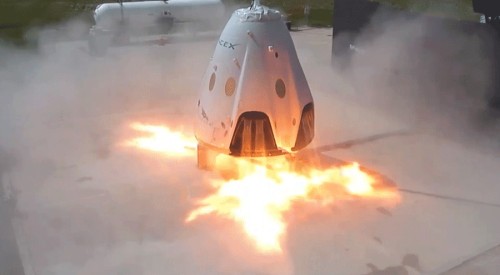
SpaceX announced they are planning to send their Red Dragon capsule to Mars as soon as 2018
To send Red Dragon spacecraft to Mars, SpaceX is building a mega-rocket called Falcon Heavy. Based on the company’s successful Falcon 9, Falcon Heavy consists of three core rocket stages, each of which is equipped with landing legs for reusability. They would use the capsule’s thrusters to make a landing.

This artist’s illustration shows how the capsule could enter Mars’ atmosphere. SpaceX has successfully returned their capsules to Earth during space station resupply missions for NASA.
The Dragon can carry seven astronauts to and from destinations like the International Space Station (not yet a manned mission to Mars I’d guess 😄). Here’s an illustration of the Dragon Version 1 (the new version has some differences), to get the idea:
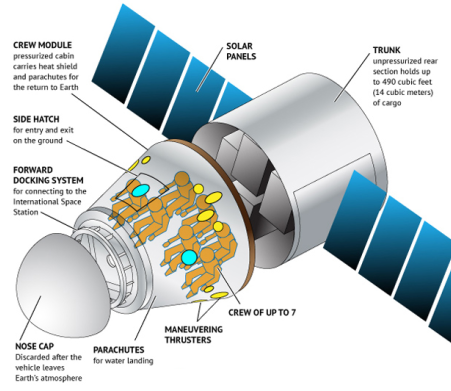
credit: SpaceX, Karl Tate/Space.com
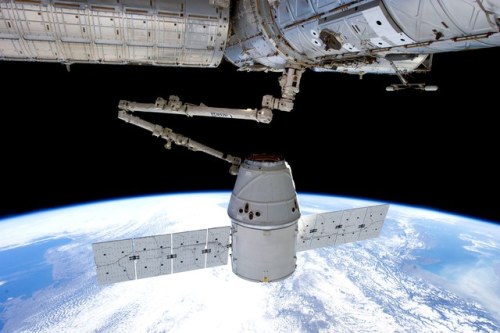
Spacex CRS-10

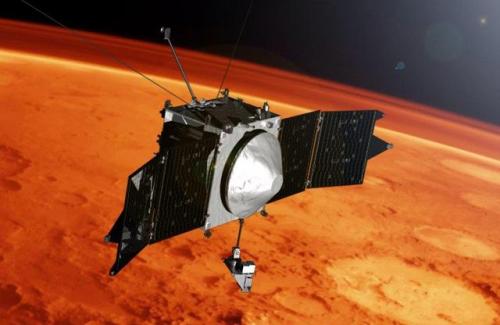
NASA’S MAVEN MISSION REVEALS MARS HAS METAL IN ITS ATMOSPHERE
Mars has electrically charged metal atoms (ions) high in its atmosphere, according to new results from NASA’s MAVEN spacecraft. The metal ions can reveal previously invisible activity in the mysterious electrically charged upper atmosphere (ionosphere) of Mars.
“MAVEN has made the first direct detection of the permanent presence of metal ions in the ionosphere of a planet other than Earth,” said Joseph Grebowsky of NASA’s Goddard Space Flight Center in Greenbelt, Maryland and lead author of a new study detailing MAVEN’s results.
“Because metallic ions have long lifetimes and are transported far from their region of origin by neutral winds and electric fields, they can be used to infer motion in the ionosphere, similar to the way we use a lofted leaf to reveal which way the wind is blowing,” Grebowsky said. The new study was published today in Geophysical Research Letters, a journal of the American Geophysical Union.
MAVEN (Mars Atmosphere and Volatile Evolution Mission) is exploring the Martian upper atmosphere to understand how the planet lost most of its air, transforming from a world that could have supported life billions of years ago into a cold desert planet today. Understanding ionospheric activity is shedding light on how the Martian atmosphere is being lost to space, according to the MAVEN team.
The metal comes from a constant rain of tiny meteoroids onto the red planet. When a high-speed meteoroid hits the Martian atmosphere, it vaporizes. Metal atoms in the vapor trail get some of their electrons torn away by other charged atoms and molecules in the ionosphere, transforming the metal atoms into electrically charged ions.
MAVEN has detected iron, magnesium, and sodium ions in the upper atmosphere of Mars over the last two years using its Neutral Gas and Ion Mass Spectrometer instrument, giving the team confidence that the metal ions are a permanent feature. “We detected metal ions associated with the close passage of Comet Siding Spring in 2014, but that was a unique event and it didn’t tell us about the long-term presence of the ions,” Grebowsky said.
The interplanetary dust that causes the meteor showers is common throughout our solar system, so it’s likely that all solar system planets and moons with substantial atmospheres have metal ions, according to the team.
Sounding rockets, radar and satellite measurements have detected metal ion layers high in the atmosphere above Earth. There’s also been indirect evidence for metal ions above other planets in our solar system. When spacecraft are exploring these worlds from orbit, sometimes their radio signals pass through the planet’s atmosphere on the way to Earth, and sometimes portions of the signal have been blocked. This has been interpreted as interference from electrons in the ionosphere, some of which are thought to be associated with metal ions. However, long-term direct detection of the metal ions by MAVEN is the first conclusive evidence that these ions exist on another planet and that they are a permanent feature there.
The team found that the metal ions behaved differently on Mars than on Earth. Earth is surrounded by a global magnetic field generated in its interior, and this magnetic field together with ionospheric winds forces the metal ions into layers. However, Mars has only local magnetic fields fossilized in certain regions of its crust, and the team only saw the layers near these areas.
“Elsewhere, the metal ion distributions are totally unlike those observed at Earth,” Grebowsky said.
The research has other applications as well. For example, it is unclear if the metal ions can affect the formation or behavior of high-altitude clouds. Also, detailed understanding of the meteoritic ions in the totally different Earth and Mars environments will be useful for better predicting consequences of interplanetary dust impacts in other yet-unexplored solar system atmospheres.
“Observing metal ions on another planet gives us something to compare and contrast with Earth to understand the ionosphere and atmospheric chemistry better,” Grebowsky said.
http://player.vimeo.com/video/62255585
Comet Panstarrs captured in gorgeous time-lapse above the skies of Boulder, CO by Patrick Cullis. Lovely stuff.
Comets are mysterious frozen chunks of stellar and planetary debris, these dirty snowballs that wander in darkness until their tails are blown bright and wide by solar winds. Some follow paths so random and eccentric that they may pass a star only once, or perhaps not at all, instead floating through interstellar space, never to be known. But for those fleeting moments, like Panstarrs’ current passage, they are like icy candles lit for our enjoyment by the breath of the sun.
A song of ice and fire, indeed.
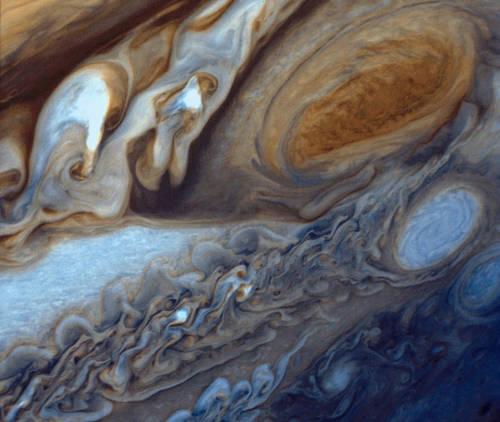
Jupiter’s Great Red Spot Viewed by Voyager 1
At about 89,000 miles in diameter, Jupiter could swallow 1,000 Earths. It is the largest planet in the solar system and perhaps the most majestic. Vibrant bands of clouds carried by winds that can exceed 400 mph continuously circle the planet’s atmosphere. Such winds sustain spinning anticyclones like the Great Red Spot – a raging storm three and a half times the size of Earth at the time of this photo, located in Jupiter’s southern hemisphere. In January and February 1979, NASA’s Voyager 1 spacecraft zoomed toward Jupiter, capturing hundreds of images during its approach, including this close-up of swirling clouds around Jupiter’s Great Red Spot.
Credit: NASA’s Goddard Space Flight Center
Come check us out for all your astronomy needs!!!
www.astrotidbits.com
-
 requins-lair reblogged this · 6 years ago
requins-lair reblogged this · 6 years ago -
 pepdart liked this · 7 years ago
pepdart liked this · 7 years ago -
 bibi-pourin liked this · 7 years ago
bibi-pourin liked this · 7 years ago -
 softundertones liked this · 7 years ago
softundertones liked this · 7 years ago -
 astrotidbits-blog reblogged this · 8 years ago
astrotidbits-blog reblogged this · 8 years ago -
 astrotidbits-blog liked this · 8 years ago
astrotidbits-blog liked this · 8 years ago -
 solarradioastronomy liked this · 8 years ago
solarradioastronomy liked this · 8 years ago -
 tthomusic liked this · 8 years ago
tthomusic liked this · 8 years ago -
 blue-star-dragon liked this · 8 years ago
blue-star-dragon liked this · 8 years ago -
 freeshfries98 reblogged this · 8 years ago
freeshfries98 reblogged this · 8 years ago -
 shooting-star-gin reblogged this · 8 years ago
shooting-star-gin reblogged this · 8 years ago -
 shooting-star-gin liked this · 8 years ago
shooting-star-gin liked this · 8 years ago -
 frankietankbaker liked this · 8 years ago
frankietankbaker liked this · 8 years ago -
 artistmachine42 liked this · 8 years ago
artistmachine42 liked this · 8 years ago -
 wonderbeansmom reblogged this · 8 years ago
wonderbeansmom reblogged this · 8 years ago -
 asad-gopalani-posts reblogged this · 9 years ago
asad-gopalani-posts reblogged this · 9 years ago -
 asad-gopalani-posts liked this · 9 years ago
asad-gopalani-posts liked this · 9 years ago -
 aspergers1044 reblogged this · 9 years ago
aspergers1044 reblogged this · 9 years ago -
 aspergers1044 liked this · 9 years ago
aspergers1044 liked this · 9 years ago -
 thetrashymermaid liked this · 9 years ago
thetrashymermaid liked this · 9 years ago -
 thegreataztecagator reblogged this · 9 years ago
thegreataztecagator reblogged this · 9 years ago -
 lucentkat liked this · 9 years ago
lucentkat liked this · 9 years ago -
 punkrockdragon liked this · 9 years ago
punkrockdragon liked this · 9 years ago -
 iwtv1976 reblogged this · 9 years ago
iwtv1976 reblogged this · 9 years ago -
 theredditer-blog liked this · 9 years ago
theredditer-blog liked this · 9 years ago -
 happy-joy-joy reblogged this · 9 years ago
happy-joy-joy reblogged this · 9 years ago -
 krazybomb liked this · 9 years ago
krazybomb liked this · 9 years ago -
 krazybomb reblogged this · 9 years ago
krazybomb reblogged this · 9 years ago -
 coolamog-the-ceaseless-hunger reblogged this · 9 years ago
coolamog-the-ceaseless-hunger reblogged this · 9 years ago -
 xxcryptidslothxx reblogged this · 9 years ago
xxcryptidslothxx reblogged this · 9 years ago -
 xxcryptidslothxx liked this · 9 years ago
xxcryptidslothxx liked this · 9 years ago -
 c3p-mo reblogged this · 9 years ago
c3p-mo reblogged this · 9 years ago -
 trinns liked this · 9 years ago
trinns liked this · 9 years ago -
 monsieurlemoo reblogged this · 9 years ago
monsieurlemoo reblogged this · 9 years ago -
 captainignis liked this · 9 years ago
captainignis liked this · 9 years ago -
 kusornatsu liked this · 9 years ago
kusornatsu liked this · 9 years ago -
 moonfl-wr liked this · 9 years ago
moonfl-wr liked this · 9 years ago -
 rawritssonita liked this · 9 years ago
rawritssonita liked this · 9 years ago -
 vic-av liked this · 9 years ago
vic-av liked this · 9 years ago -
 jaimedoit liked this · 9 years ago
jaimedoit liked this · 9 years ago -
 deathlaw liked this · 9 years ago
deathlaw liked this · 9 years ago